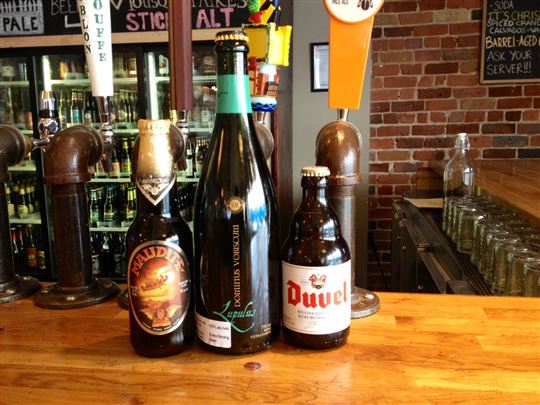The Influence of Belgian Beers in the Modern Craft Beer World

It’s no secret that Belgian beer has left its imprint in the craft beer world while heavily influencing methods of brewing, marketing and adjunct ingredients that go into cultivating some of these delicious liquid libations. Perhaps we can blame its rich cultural and political history for making Belgian styles of beer world famous?
While other neighbouring European countries (ie. France) maintain an ideal climate for producing quality wine, Belgium’s cooler climate seems better suited for growing hops and barley. What France has done for the international wine industry, Belgium has done for the modern international craft beer scene.
Belgium remains split linguistically, politically and religiously thanks to a tumultuous history. The moulés-et-frites eating country endured a good rally first under the French, and then Dutch rule prior to gaining its own sovereignty. The country was deeply affected by both World Wars having much of its brewing equipment raided for valuable copper- bringing most of their crafty beer production to a temporary halt. Luckily, the country retaliated with a vengeance on the beer market, in not only within their own territory- but around the globe. Soon, brewery after brewery around the world began mimicking classic styles of Belgian beer. They say imitation is the best form of flattery, right?
Belgian beer styles today combine French ‘flair’, Dutch sturdiness and German precision. It’s not to say that ‘Old World’ countries like Germany or England do not hold a deep-rooted history in beer production (or even further back into ancient Sumerian civilization boasting the oldest beer recipe- 3900 years old, according to Wikipedia– but nobody can argue that any other country has heavily inspired the craft beer world around the globe as much as the Belgium has. As Garrett Oliver, the Brewmaster of the Brooklyn Brewery in New York, New York points out, “In many ways….Belgium’s brewers have exerted a large influence on modern craft brewing” (Oliver, p.122, The Oxford Companion to Beer).
Over the last couple of weeks, we have explored Trappist and Abbey ales- six of which reside in Belgium. It is no secret that these two categories have played a major role beer making history, period. While their recipes and ingredients (dating back to the Middle Ages) may have changed slightly over the course of time, for the most part- the tenacious and methodical brewing in congruence with their ageing process, has remained traditionally the same. It has often been mimicked by other ‘New World’ countries, especially within the North American continent.
Some stylistic qualities, which we highlighted in last week’s blog include its classically warm, top-fermentation process, and unique yeast strains giving that notorious fruity and spicy ‘Belgian character’. Common ‘adjuncts’ to Belgian styles of beer include orange peel, black pepper and star anise. Both Pilsner and Vienna malts are also commonly used within Belgian or Belgian ‘style’ beer production. Bottle conditioning is also another practise that has caught the eye of many international brewers willing to experiment. The list could go on, but we don’t have all day here- and neither do you! Wouldn’t you rather ‘drink it to believe it’?
Belgian beer influence on the rest of the craft beer scene did not rest at simply method or ingredient – its quintessential association with religion (specifically Catholicism) be it holy or evil, has also impacted beer marketing on an international level. If you recall in last week’s blog, we touched upon early examples of Abbey ales which were labelled with pictures of saints or monks, in hopes that people would buy into a “good quality” and “wholesome product”- truthful or not. On the other end of the spectrum, there’s a well-known Belgian brewery by the name of Moortgat boasting one of its most popular Belgian strong ales, Duvel. Its name literally translates to ‘devil’ in English, the short video on the brewery’s history is explains how its name came to be.
Some close-to-home examples of the influence of Belgian beer ‘marketing’ include some popular Quebecois breweries such as Unibroue’s “La Maudite” (a Belgian style dubbel), and Charlevoix’s “Dominus Vobiscum Lupulus” (a strong Belgian style golden ale). Unibroue’s labels such as their “La Maudite” and “La Fin Du Monde” (a Belgian style tripel) allude to morbid and devilish themes while their flavour profiles align with Belgian style Trappist ales.
Charlevoix’s “Dominus Vobiscum” (which translates from Latin to English as “The Lord be with You”) nestles well within the holy ‘doctrine’ of Belgian beer making history pioneered by Trappist monks. It seems slightly ironic that both Heaven and Hell references are used as marketing ploys in the beer world- but stranger things have happened. Just like drinking Budweiser won’t always get you girls and a pool party (or maybe it will??), drinking these Belgian style beauties will neither erase your ‘sins’ nor grant you a free pass into Heaven or Hell…..Or will it??
Other key Belgian styles of beer include: Saisons (farmhouse ale), red and brown ales, and an array of Belgian ‘Wits’ (wheat beer)- and let us not forget about the funky sour Lambics! There is much to explore in the Belgian beer making world, and the rest of the world is still thirsty for more!
Written by Kristin Perrin
Originally posted for Brother Bistro Blog
References: The Oxford Companion to Beer, by: Garrett Oliver
